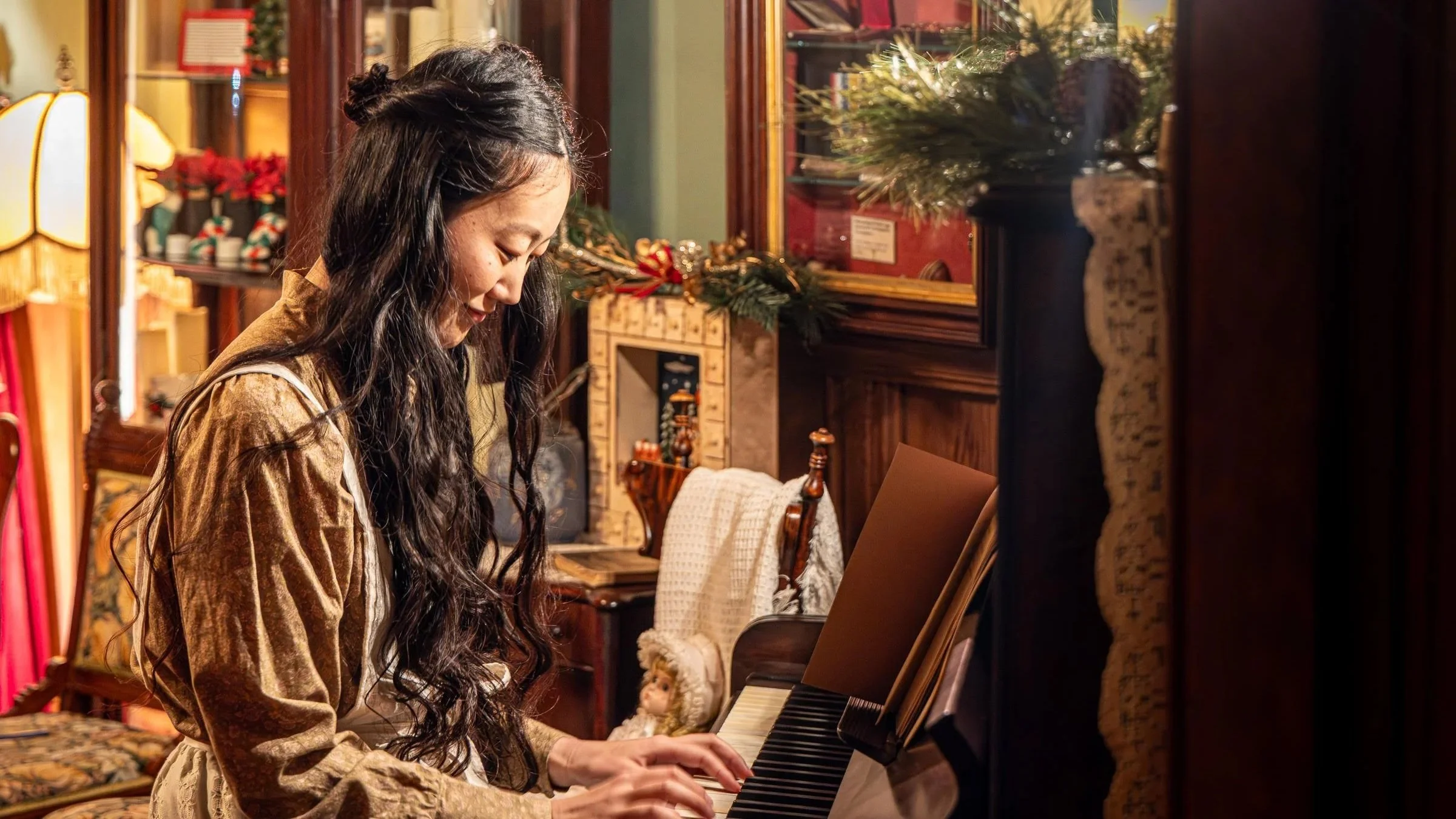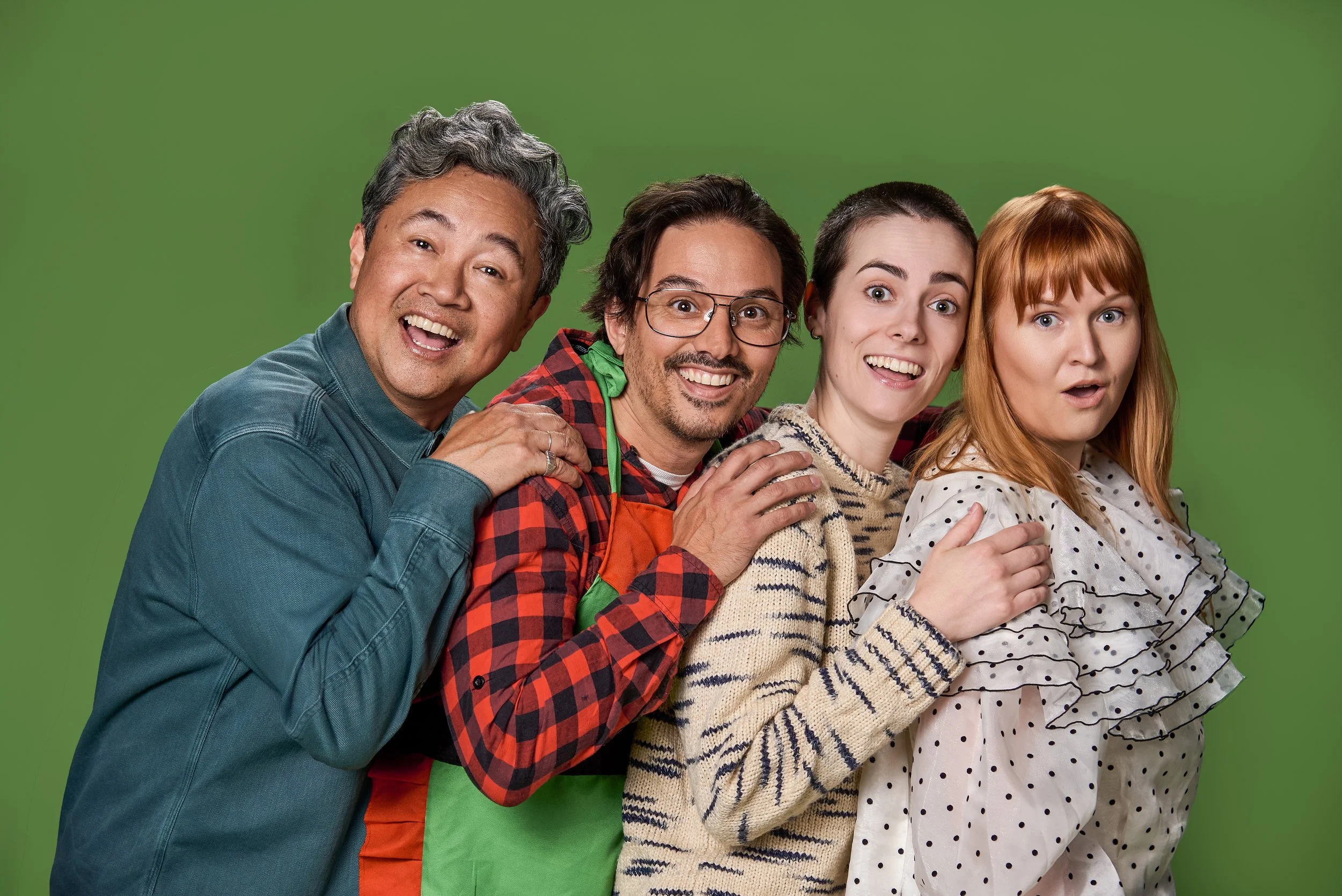In late Nisga'a playwright Larry Guno's Bunk #7, actors Kiefer Collison and Nick Dangeli tell a true story of Indigenous resilience
Directed by Marianne Brørup Weston with dramaturg Yvette Nolan, play about residential-school riot draws upon generational connections, humour, and strength
Percy Stephens (left) and Kiefer Collison in Bunk #7. Photo by Patrick Shannon
Shadbolt Centre for the Arts presents Bunk #7 from September 27 to 29 at 7:30 pm at the James Cowan Theatre
FAMILY TIES RUN DEEP in Bunk #7, a true story of a residential-school riot produced by The Raven Collective, for one of the play’s lead actors, Kiefer Collison.
Haida Gwaii-raised Collison plays 16-year-old fisherman Gunay in Bunk #7, a character from Old Massett based on the real-life David Parnell Sr.—his own great uncle, who passed away in a fishing accident many years ago. Gunay, Collison says, is playful yet serious, well-spoken, and ultimately the glue that holds people together.
“I think it gave me a real sense of comfort to be myself and really draw from my own experiences of being Haida, being a fisherman, and just straight up being Indigenous,” Collison says. “It gave me a sense of knowing who Gunay was, being from Old Massett myself, and kind of the humour that we’ve had passed down to us from our aunts and uncles. So there’s a real level of comfort that I instantly had with Gunay, as soon as I read it off the paper. I think just having the family connection really gives me a sense of confidence in the character, and helps me bring Gunay to life.”
Stir sat down over Zoom with Collison, fellow lead actor Nick Dangeli, and Bunk #7’s director Marianne Brørup Weston, ahead of the production’s run at the Shadbolt Centre for the Arts. Written by late Nisga’a MLA Larry Guno and developed with dramaturgy from revered Algonquin playwright Yvette Nolan, Bunk #7 is based around Guno’s experience at the Edmonton Indian Residential School in St. Albert, Alberta from 1960 to 1961. After a change in supervisors at the institution fuels harmful conditions and incidents, six teenage boys—including Collison’s character Gunay—start a riot in protest.
A public speaker and media personality, Collison was born and grew up in the village of Old Massett. He represented Indigenous culture while competing on season 9 of Big Brother Canada in 2021, securing fourth place and the title of Canada’s Favourite HouseGuest. Nowadays, Collison hosts the Midday show on Canada’s First Nations Radio.
With performances of the play planned just before Truth and Reconciliation Day on September 30, Collison, Dangeli, and Brørup Weston agree there is much for audiences to learn from watching the historical story of resilience.
“You know, we talk about Truth and Reconciliation Day,” Collison says, “which is often referred to as Orange Shirt Day, and there’s really no weight behind it. But this kind of puts emotion, and visuals, and reality into the statistics, into the numbers. It gives Canadians a glimpse, and it humanizes us as Indigenous people going through these traumatic times, and it humanizes our struggles.
Marianne Brørup Weston.
“So for me to be able to help shed light on some of that—on helping people turn over a new leaf as to what Truth and Reconciliation Day actually is, as to why people wear orange shirts. It’s given me a different perspective as well, as an Indigenous person.”
The play has been in the works for more than 20 years, and was first conceptualized when Brørup Weston met Guno in 2000. After hearing Guno’s story, Brørup Weston noted that it would make an impactful play, and Guno agreed. Many attempted premieres ensued, including one in 2006 at Toronto’s Native Earth Performing Arts (which was under Nolan’s artistic direction at the time), but it was ultimately cancelled following Guno’s sudden death just months prior. Finally, an in-progress version of Bunk #7 premiered in Terrace, B.C. in November 2021.
Brørup Weston, who has been involved in community theatre for more than three decades now, immigrated to B.C. from Denmark in 1966. At that time, and for many years afterwards, Indigenous history was not taught in schools. Brørup Weston says she hopes Bunk #7 can offer folks an understanding of the suffering caused through intergenerational trauma.
“Over the years, I’ve always yearned for a way to express my appreciation of Indigenous culture, in terms of storytelling, sound, art, and so on,” she says. “And this was an incredible opportunity to do that, juxtaposed to the very sterile institutional imagery and atmosphere of a residential school.”
Dangeli plays 18-year-old Gray in Bunk #7, the Nisga’a character based on Guno himself. Throughout the play, Gray attempts to lay low while finishing high school, explains Dangeli—but along the way, he ends up gaining a meaningful brotherhood and bond with his classmates. The play’s title, Bunk #7, refers to the bunk Guno occupied during his time in residential school.
Born in Omak, Washington and raised in Burnaby, Dangeli says he finds a strong sense of connection to the story through his family heritage in the same Nisga’a clan as Guno.
Nick Dangeli. Photo by Patrick Shannon
“In the end, we’re doing what our people have been doing since time immemorial: showcasing our practices,” Dangeli says of Bunk #7. “You see that in the show with our language, with our foods, with our culture, with the songs, and you hear all of that. And our ancestors—those who we lost in those schools, and those who are still here today—they truly weren’t just surviving, but now we’re able to thrive from all of them. And it’s just a really huge honour.”
Along with his Nisga’a roots, Dangeli hails from six other nations across Northern B.C. and Eastern Washington: Colville, Tsimshian, Tlingit, Haida, Gitxsan, and Tsetsaut. The actor-model-filmmaker’s experience with live performance stems from years spent dancing with his family in the Northwest Coast mask-dancing group Git Hayetsk (People of the Copper Shield).
“Feeling comfortable on stage, and then performing, and hearing people laughing—it gives you that energy,” he shares. “Especially when we’re on stage together, we’re feeding off of each other. You can really feel that it just uplifts the show more and more.”
Throughout dark times, notes Dangeli, it’s resilience, humour, and connection to culture that keep many Indigenous folks going. Collison adds that the visibility of being an Indigenous person on stage in Bunk #7 is an important aspect of the play.
“Reconciliation is such a messed-up word,” says Collison. “I don’t think anyone really knows what it means. I know for myself, I’m still having trouble truly understanding what reconciliation looks like between Indigenous communities and, for lack of a better term, non-Indigenous communities. I just want people to take commonality—and not have sympathy, but have an understanding of why we’re wearing orange shirts, of why we need Indigenous voices to be heard. As to why you might see some Indigenous people who are struggling with the intergenerational trauma that is passed down from residential schools, and then to be on Earth.
“This play is not something that is easy for people to watch. It doesn’t matter if you’re Indigenous, it doesn’t matter who you are. But I think the story is so important. And I think that the message is so important that I hope they can take away that this is more than a statistic. More than anything, this is the way people used to live. And this is how we choose to honour them, is with this story and with this play. So I just hope that they have a better understanding of who we are and where we came from.”
Bunk #7. Photo by Patrick Shannon
















